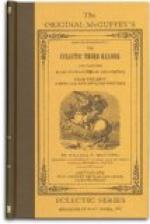Subject page
Perseverance 25
Popping Corn 35
The Monkey 40
Piccola 49
True Manliness 53
A Ship in a Storm 56
Two Ways of Telling a Story 60
The Lion 69
Harry and his Dog 81
Circumstances alter Cases 92
Evening Hymn 98
How Margery Wondered 100
Susie’s Composition 107
Coffee 117
The Horse 128
The Sandpiper 135
Robinson Crusoe’s Dress 147
A Chinese Story 158
Which? 169
Which? 170
Dare to do Right 185
The Old Oaken Bucket 202
Rivermouth Theater 215
The Attack on Nymwegen 234
The Inchcape Rock 251
PUNCTUATION MARKS. (7)
1. The Hyphen (-) is used between syllables and between the parts of a compound word; as, No-ble, col-o-ny, and text- book, easy-chair.
2. The Comma (,), the Semicolon (;), and the Colon (:) denote grammatical divisions.
Note—These marks do not indicate the comparative length of the pauses to be made where they occur.
3. The Period (.) is placed at the end of a sentence. It is also used after an abbreviation; as, God is love. Dr. Eben Goodwin.
4. The Interrogation point (?) denotes a question; as, Has he come? Who are you?
5. The Exclamation point (!) denotes strong feeling; as, Oh Absaom! my son! my son!
6. Quotation marks (” “) denote the words of another; as, God said, “Let there be light.”
7. The Apostrophe (’) denotes that a letter or letters are left out; as, O’er, for over; ’t is, for it is. It also denotes the possessive case; as, John’s hat.
8. The Curves ( ) include what, if omitted, would not obscure the sense. The parenthesis, or words included by the curves, should be read in a low key, and with greater rapidity than the rest of the sentence.
9. Brackets [ ] include something intended to exemplify what goes before, or to supply some deficiency, or rectify some mistake.
10. A Dash (-) denotes a long or significant pause, or an abrupt change or transition in a sentence.
11. Marks of Ellipsis (***) indicate the omission of letters of a word, or words of a sentence; as, P * * * * e J**n, for Prince John; the ******* was hung, for the traitor was hung.
Sometimes a long line, or a succession of dots is used instead of stars; as, J--n A---s, for John Adams; the D..e W.....m, for the Duke William.
12. A Brace (}) is used to connect several lines or words together.




